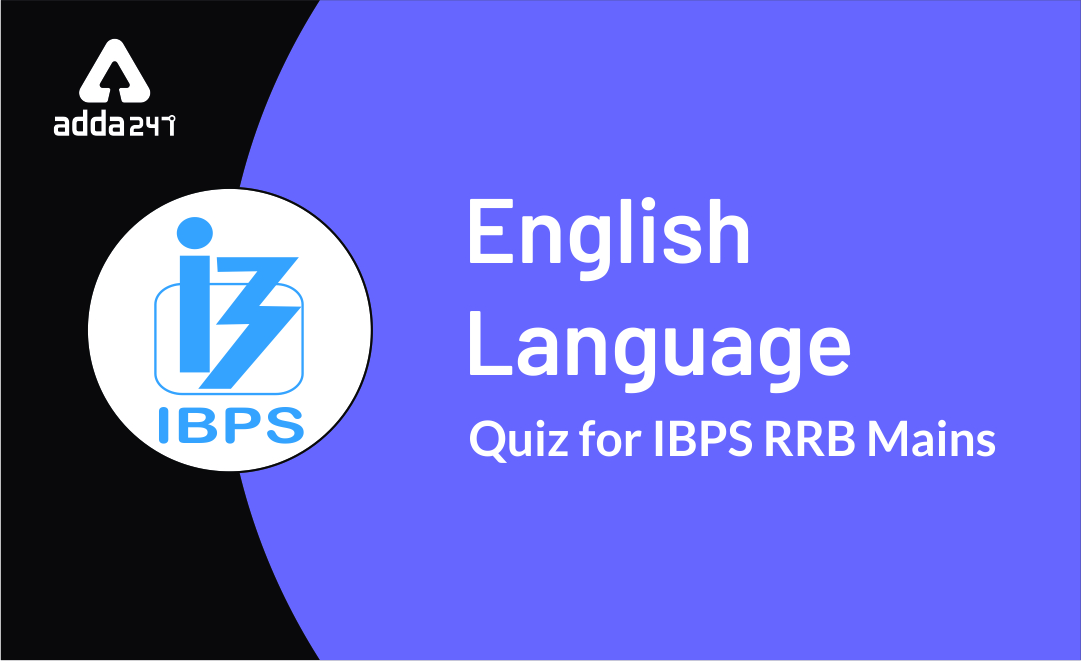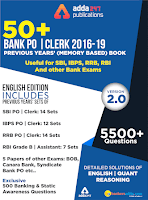
IBPS RRB PO/Clerk Main English Quiz
With every day passed, competition is increasing in leaps and bounds and it is necessary to work smarter to sail through any exam. Having a proper study plan and the updated questions to brush up your knowledge in addition to well-organized study notes for the same can help you with your preparation. IBPS RRB PO/Clerk is going to be the tough exam so you can not afford to leave any important topics. If you deal with the section with accuracy, it can do wonders and can fetch you good marks. As English is the most dreaded subject among students, we are here to provide you with the new questions with the detailed solution so that you can make it this time in IBPS RRB PO/Clerk mains. Here is the English quiz for 9th September 2019. This quiz is based on topic-
Reading comprehension and Misspelt.
Directions (1-8): Read the given passage and answer the following questions based on the passage.
Last month, the United Nations released the 26th revision of World Population Prospects and forecast that India will overtake China as the most populous country by 2027. The only surprise associated with this forecast is the way it was covered by the media. We have known for a long time that India is destined to be the most populous country in the world. Population projections are developed using existing population and by adjusting for expected births, deaths and migration. For short-term projections, the biggest impact comes from an existing population, particularly women in childbearing ages. Having instituted a one-child policy in 1979, China’s female population in peak reproductive ages (between 15 and 39 years) is estimated at 235 million (2019) compared to 253 million for India. Thus, even if India could institute a policy that reduces its fertility rate to the Chinese level, India will overtake China as the most populous country.
The element of surprise comes from the date by which this momentous event is expected. The UN revises its population projections every two years. In 2015, it was predicted that India would overtake China in 2022, but in the 2019 projections it is 2027. The UN has revised India’s expected population size in 2050 downward from 1,705 million in 2015 projections to 1,639 million in 2019 projections. This is due to faster than expected fertility decline, which is good news by all counts. Like it or not, India will reign as the most populous country throughout most of the 21st century. Whether we adjust to this demographic destiny in a way that contributes to the long-term welfare of the nation or not depends on how we deal with three critical issues. First, do we need to adopt stringent population control policies? History tells us that unless the Indian state can and chooses to act with the ruthlessness of China, the government has few weapons in its arsenal. Almost all weapons that can be used in a democratic nation, have already been deployed. These include restriction of maternity leave and other maternity benefits for first two births only and disqualification from panchayat elections for people with more than two children in some States along with minor incentives for sterilization.
As demographer Judith Blake noted, people have children, not birth rates and few incentives or disincentives are powerful enough to overcome the desire for children. Ground-level research by former Chief Secretary of Madhya Pradesh Nirmala Buch found that individuals who wanted larger families either circumvented the restrictions or went ahead regardless of the consequences. As one of her informants noted, “The sarpanch’s post is not going to support me during my old age, but my son will. It does not really matter if I lose the post of sarpanch.”Second, if punitive actions won’t work, we must encourage people to have smaller families voluntarily. There are sharp differences in fertility among different socio-economic groups.
In western societies, low fertility is associated with the conflict that working women face between work and child rearing and the individual’s desire to enjoy a child-free life. Not so for Indian couples. In India, couples with one child do not consume more nor are women in these families more likely to work. My research with demographer Alaka Basu from Cornell University shows that it is a desire to invest in their children’s education and future prospects that seems to drive people to stop at one child. Richer individuals see greater potential for ensuring admission to good colleges and better jobs for their children, inspiring them to limit their family size. Thus, improving education and ensuring that access to good jobs is open to all may also spur even poorer households into having fewer children and investing their hopes in the success of their only daughter or son. Provision of safe and easily accessible contraceptive services will complete this virtuous cycle. Third, we must change our mindset about how population is incorporated in broader development policies.
Q1. According to the given passage, where does the biggest impact come from for short-term projection?
(a) Existing population especially from women who are in an age of child bearing.
(b) Adjustment of migration, deaths and expected births.
(c) getting it covered by media
(d) Instituing a one-child policy.
(e) none of the above
S1. Ans. (a)
Sol. Referring to the first paragraph, option (a) is the right answer choice. “For short-term projections, the biggest impact comes from an existing population, particularly women in childbearing ages.”
Q2. As per the given passage, what is/are the cause(s) of India’s expected population size in 2050 getting downwards?
(a) Due to UN’s prediction that India would overtake China.
(b) Declination of expected fertility rate faster than usual.
(c) Revision of population projection by UN every two years
(d) Both (a) and (b)
(e) None of the above
S2. Ans. (b)
Sol. Referring to the second paragraph, answer (b) is the right answer choice.
What is/are the weapons government has deployed to act with ruthlessness of China?
(a) restriction of maternity leave for first two births only
(b) Maternity benefits for first two births only
(c) Disqualifying people with more than two children from panchayat elections
(d) All of the above
(e) None of these
S3. Ans. (d)
Sol. Referring to the paragraph second, option (d) is the right answer choice.
Q4. According to the demographer Judith Blake, what is sufficient to overcome the desire for children?
(a) Few incentives or disincentives
(b) Restricting all the benefits
(c)Disqualifying people from major roles of society
(d) Both (b) and (c)
(e) None of these
S4. Ans. (a)
Sol. Referring to the third paragraph, option (a) is the right answer. “As demographer Judith Blake noted, people have children, not birth rates and few incentives or disincentives are powerful enough to overcome the desire for children. “
Q5. What is the cause of low fertility rate in western societies
(a) Life of women getting stuck between work and child rearing
(b) Restricting individual’s desires to enjoy a life without children
(c) Both (a) and (b)
(d) Children are considered as a financial burden
(e) none of these
S5. Ans. (c)
Sol. Referring to the fourth paragraph, option (c) is the right answer choice.
Q6. How can even poorer households be spurred to have fewer children?
(a) Improving education
(b) Ensuring access of good jobs is open to all
(c) Granting medical facilities for only one child.
(d) Both (a) and (b)
(e) All of the above
S6. Ans. (d)
Sol. Referring to the Fourth paragraph, option (d) is the right answer choice. “Thus, improving education and ensuring that access to good jobs is open to all may also spur even poorer households into having fewer children and investing their hopes in the success of their only daughter or son.”
Q7. Which of the following words is most similar in meaning with STRINGENT highlighted in the given passage?
(a) Strict
(b) Linient
(c) Flexible
(d) Convincing
(e) Compressed
S7. Ans. (a)
Sol. Option (a) is the right answer choice.
Stringent- (of regulations, requirements, or conditions) strict, precise, and exacting.
Q8. Which is the following is the most opposite in meaning with RUTHLESSNESS highlighted in the passage?
(a) tyrannical
(b) Compassionate
(c) Barbrous
(d) Relentless
(e) Abominable
S8. Ans. (b)
Sol. Option (b) is the right answer choice.
Ruthlessness- the quality of lacking pity or compassion for others.
Directions (9-15): In each Question below, a sentence is given with four words given in Bold in the sentence. Among these bold words one may be wrongly spelt. The option of that word is the answer. If all four words are correctly spelt mark ‘e’. i.e. ‘All Correct’ as the answer.
Q9. When it came evident that Saudi Arabia was not winning the war, fisures started emerging within the coalition.
(a) Evident
(b) Fisures
(c) Emerging
(d) Coalition
(e) All correct
S9. Ans. (b)
Sol. The correct answer choice is (b). Correct spelling is “fissures”.
Q10. The U.S. has signalled that it will facelitate talks among the multiple factions in Yemen through Oman, a neutral player.
(a) Signalled
(b) Facelitate
(c) Factions
(d) Neutral
(e) All Correct
S10. Ans. (b)
Sol. The correct answer choice is (b). Correct spelling is “facilitate”.
Q11. The apex court’s power to transfer is not unfetered and absolute and can only be carried out in public interest for better administration of justice.
(a) Transfer
(b) Unfetered
(C) Interest
(d) Administration
(e) all correct
S11. Ans. (b)
Sol. The correct answer choice is (b). Correct spelling is “unfettered”.
Q12. The functioning of the collegeum has attracted much criticism, largely due to aberrations in certain selections and transfers.
(a) Functioning
(b) Collegeum
(c) Criticism
(d) Aberrations
(e) All correct
S12. Ans. (b)
Sol. The correct answer choice is (b). Correct spelling is “Collegium”.
Q13. The most pertinent question here is whether the transfer serves the inetrests of administration of justice for the people of Tamil Nadu.
(a) Pertinent
(b) Transfer
(c) Inetrests
(d) Justice
S14. Ans. (c)
Sol. The correct answer choice is (c). Correct spelling is “interests”.
Q14. Due to the puzzling facts relating to Justice Tahilramani’s transfer, rumuors are rife on social media and in court corridors.
(a) Puzzling
(b) Rumuors
(c) Social
(d) Corridors
(e) All correct
S14. Ans. (b)
Sol. The correct answer is (b). Correct spelling is “rumours”.
Q15. The M5S leader Luigi Di Maio would be obliged to temper his populist anti-EU retoric, which at times bordered on suggestions to the effect.
(a) Obliged
(b) Populist
(c) Retoric
(d) Suggestions
(e) All correct
S15. Ans. (c)
Sol. The correct answer choice is (c). Correct spelling is “rhetoric”.
All the Best BA’ians for IBPS RRB PO/Clerk Main!!




 English Quiz For NIACL AO Mains 2024 Exa...
English Quiz For NIACL AO Mains 2024 Exa...

